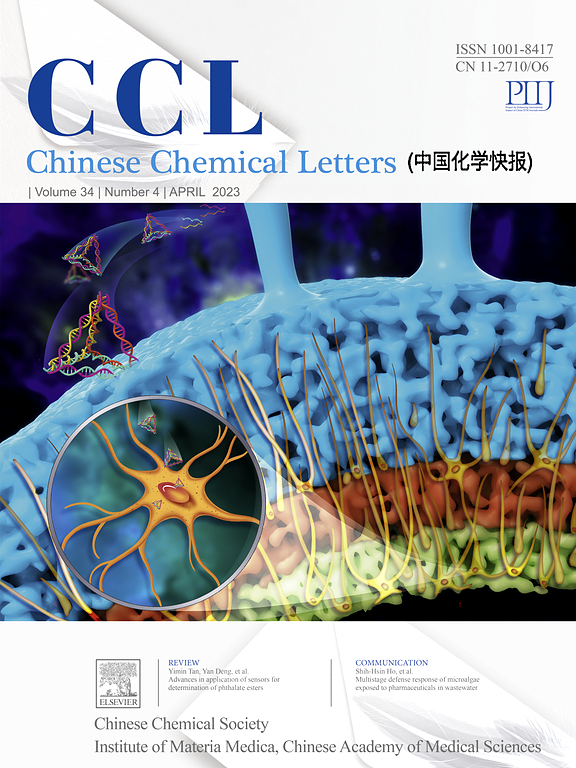Polymer microparticles with ultralong room-temperature phosphorescence for visual and quantitative detection of oxygen through phosphorescence image and lifetime analysis
IF 9.4
1区 化学
Q1 CHEMISTRY, MULTIDISCIPLINARY
引用次数: 0
Abstract
Room-temperature phosphorescence (RTP) materials exhibiting long emission lifetimes have gained increasing attention owing to their potential applications in encryption, anti-counterfeiting, and sensing. However, most polymers exhibit a short RTP lifetime (<1 s) because of their unstable triplet excitons. Herein, a new strategy of polymer chain stabilized phosphorescence (PCSP), which yields a new kind of RTP polymers with an ultralong lifetime and a sensitive oxygen response, has been reported. The rigid polymer chains of poly(methyl mathacrylate) (PMMA) immobilize the emitter molecules through multiple interactions between them, giving rise to efficient RTP. Meanwhile, the loosely-packed amorphous polymer chains allow oxygen to diffuse inside, endowing the doped polymers with oxygen sensitivity. Flexible and transparent polymer films exhibited an impressive ultralong RTP lifetime of 2.57 s at room temperature in vacuum, which was among the best performance of PMMA. Intriguingly, their RTP was rapidly quenched in the presence of oxygen. Furthermore, RTP microparticles with a diameter of 1.63 μm were synthesized using in situ dispersion polymerization technique. Finally, oxygen sensors for quick, visual, and quantitative oxygen detection were developed based on the RTP microparticles through phosphorescence lifetime and image analysis. With distinctive advantages such as an ultralong lifetime, oxygen sensitivity, ease of fabrication, and cost-effectiveness, PCSP opens a new avenue to sensitive materials for oxygen detection.

具有超长室温磷光的聚合物微颗粒,通过磷光图像和寿命分析用于氧的视觉和定量检测
具有长发射寿命的室温磷光材料由于其在加密、防伪和传感方面的潜在应用而受到越来越多的关注。然而,由于其不稳定的三重态激子,大多数聚合物表现出较短的RTP寿命(<1 s)。本文报道了一种新的聚合物链稳定磷光(PCSP)策略,该策略产生了一种具有超长寿命和敏感氧响应的新型RTP聚合物。聚甲基丙烯酸甲酯(PMMA)的刚性聚合物链通过它们之间的多重相互作用固定发射器分子,从而产生高效的RTP。同时,松散排列的无定形聚合物链允许氧气在内部扩散,赋予掺杂聚合物氧敏感性。在室温真空条件下,柔性透明聚合物薄膜的RTP寿命为2.57 s,是PMMA的最佳性能之一。有趣的是,他们的RTP在氧气的存在下迅速熄灭。采用原位分散聚合技术合成了直径为1.63 μm的RTP微颗粒。最后,通过磷光寿命和图像分析,开发了基于RTP微粒的快速、视觉和定量氧检测的氧传感器。PCSP具有超长使用寿命、氧敏感性、易于制造和成本效益等独特优势,为敏感材料的氧检测开辟了新的途径。
本文章由计算机程序翻译,如有差异,请以英文原文为准。
求助全文
约1分钟内获得全文
求助全文
来源期刊

Chinese Chemical Letters
化学-化学综合
CiteScore
14.10
自引率
15.40%
发文量
8969
审稿时长
1.6 months
期刊介绍:
Chinese Chemical Letters (CCL) (ISSN 1001-8417) was founded in July 1990. The journal publishes preliminary accounts in the whole field of chemistry, including inorganic chemistry, organic chemistry, analytical chemistry, physical chemistry, polymer chemistry, applied chemistry, etc.Chinese Chemical Letters does not accept articles previously published or scheduled to be published. To verify originality, your article may be checked by the originality detection service CrossCheck.
 求助内容:
求助内容: 应助结果提醒方式:
应助结果提醒方式:


